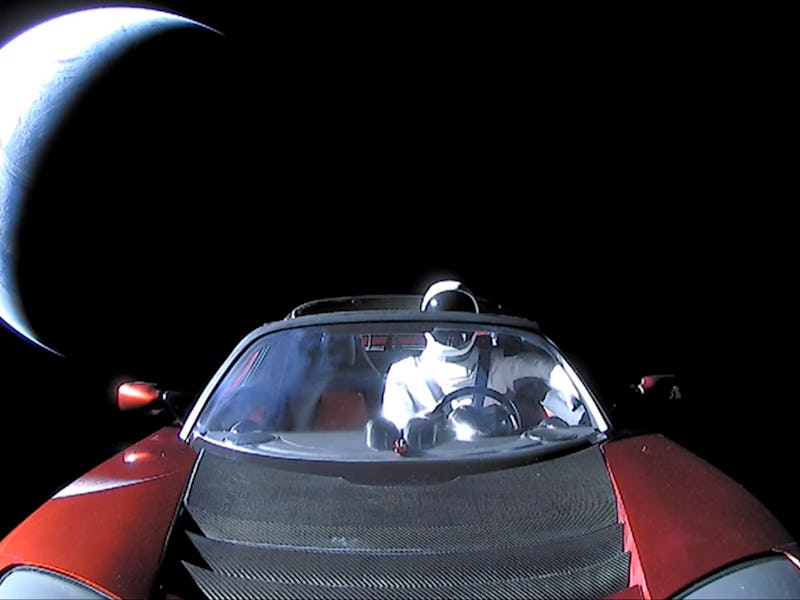SpaceX: How a Mars “spy satellite” engineer tracked Musk’s Tesla Roadster
An engineer who helped develop a camera for Mars has built a tool to track the most fascinating car in the Solar System.

Elon Musk’s Tesla Roadster has been on an impressive journey around the Solar System — and a Mars “spy satellite” engineer has helped track its journey.
Ben Pearson is a 36-year-old Huntsville, Alabama-based aerospace engineer. He’s also the creator of the Where is Roadster website. The website has tracked Musk’s Roadster ever since it launched on the first flight of the Falcon Heavy rocket on February 8, 2018.
Pearson has experience with groundbreaking objects in space. While at the University of Arizona, Tucson, Pearson got the chance to work on the High Resolution Imaging Experiment, also known as HIRISE. This 143-pound camera was launched on the Mars Reconnaissance Orbiter in 2005, where it studies the planet’s atmosphere.
“It’s essentially a spy satellite for Mars,” Pearson tells Inverse.
Want to find out more about the surprise visitor HIRISE spotted 15 years later, how Musk reacted to Pearson’s project, and the huge SpaceX project Pearson wants to track next? Read the full interview with Ben Pearson, only in MUSK READS+.
Pearson was quoted in a local Tucson news website in 2006 after the first high-resolution images were beamed back to Earth. Pearson described the image quality at the time as “incredible [...] we knew somewhere in our minds that this was what it was capable of. But, when you actually see it …"
SpaceX’s February 2018 launch stunned spaceflight fans. In the test payload was Musk’s personal red Tesla Roadster, kitted out with a series of extras:
- A dummy wearing a SpaceX spacesuit, dubbed “Starman.”
- A reference to Hitchhiker’s Guide to the Galaxy with the words “don’t panic” emblazoned on the dashboard.
- A “5D quartz laser storage device” containing Isaac Asimov’s Foundation books.
The car was sent on a trajectory around the Solar System, careering away from the Earth and toward Mars’ orbit. Pearson noticed that it seemed SpaceX was just going to send the Roadster on its way. No tracker, no nothing.
“The next day I saw that a lot of people were trying to figure out where it was,” he says.
Pearson leapt into action. He registered the domain name, and after he got home from work, he started coding.
Ben Pearson's website Where is Roadster in action, tracking the estimated location of Musk's red Tesla Roadster.
The website uses data from NASA’s Jet Propulsions Laboratory (JPL). The organization tracked the car in its early days, while it was still visible by telescopes, and built out a long-term projection of its trajectory. The car would be too far to see from an Earth-based telescope at this stage.
Over the past three years, the website has cataloged an impressive series of milestones — and even caught the attention of Musk himself.
TO READ THE FULL INTERVIEW WITH BEN PEARSON, SUBSCRIBE TO MUSK READS+.
Here is what you will gain from subscribing to MUSK READS+:
- Three emails per week, enabling fans to go deeper into the week’s news.
- Original interviews and reporting, longform analysis, previews, and recaps of major events, including earnings calls and more.
- Community-focused extras like responses to reader mail, an upcoming event calendar, and notable anniversaries.
- An archive of previous subscriber-only content, so you can easily read back over what you might have missed.
- Promotional deals and offers.
- Supporting original, independent journalism.
MUSK READS+ is a fully independent operation. We are not Elon Musk, nor are we employed by him. Our job is to report the events we find newsworthy, giving you the inside look at the worlds of space rockets, electric cars, clean energy, and more. It means first-hand accounts of a SpaceX rocket launch, Tesla insights from third-party analysts, and more.
If you want to support us in our mission, and receive original interviews and analysis, consider contributing with a subscription.
This article was originally published on